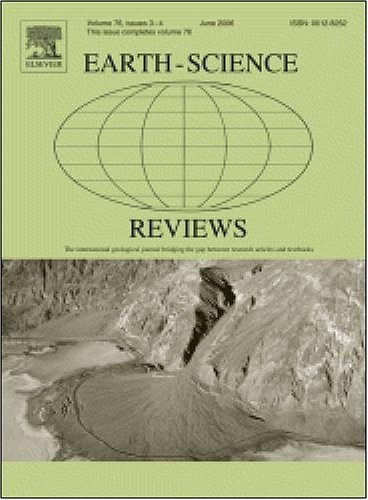从多样化到灭绝:奥陶纪的海洋和气候背景
IF 10
1区 地球科学
Q1 GEOSCIENCES, MULTIDISCIPLINARY
引用次数: 0
摘要
奥陶纪(470-443 Ma)经历了从奥陶纪生物大多样化事件(GOBE)到晚奥陶纪大灭绝(LOME)的史诗级进化轨迹,标志着生物多样性的空前兴衰。气候、海洋和地质事件之间复杂的相互作用驱动了碳循环和环境异质性的波动。在这里,我们回顾了这段时间内生物进化、元素循环、气候变化、大气成分和海洋氧化还原结构及其相互作用的关键进展。我们采用群落地球系统模型(CESM),在10-Myrs的时间片分辨率下探讨生物更替的影响因素。我们的模拟表明,增加的有机碳埋藏引发了长期的冷却,最终在希尔南提冰期达到顶峰,碳同位素扰动,以及大气中氧气的增加和二氧化碳的减少。在长期尺度上,含氧的海洋水团在世界范围内扩张,而低纬度大陆的大陆海仍处于缺氧状态。结果表明,冈瓦纳西翼赤道地区La Niña-like上升流增强导致了海洋结构的不稳定。这种不均匀的氧化还原结构和洋流的重组可能标志着整个地球历史上最基本的海洋氧化过程之一的结果。这种环境异质性也解释和调和了来自不同古生物数据库的GOBE持续时间估计的差异。我们的回顾和模拟一致支持奥陶纪环境变化和生物进化之间的动态相互作用。本文章由计算机程序翻译,如有差异,请以英文原文为准。
Diversification to extinction: oceanic and climatic context of the Ordovician
The Ordovician (470–443 Ma) witnessed an epic evolutionary trajectory, from the Great Ordovician Biodiversification Event (GOBE) to the Late Ordovician Mass Extinction (LOME), marking an unprecedented rise and fall in biodiversity. Complex interactions among climate, ocean, and geological events, drove fluctuations in the carbon cycle and environmental heterogeneity. Here, we review key developments within this interval pertaining to biological evolution, elemental cycling, climate change, atmospheric composition, and marine redox structure and their mutual interactions. We employ the Community Earth System Model (CESM) to explore the factors underpinning the biotic turnover with a resolution of 10-Myrs time slice. Our simulations suggest that increased organic carbon burial triggered long-term cooling culminating in the Hirnantian ice age, carbon isotopic perturbations, alongside rising atmospheric oxygen and declining CO₂. On a secular scale, oxic oceanic water masses expanded worldwide, while the continental seas of the low-latitude landmasses remained oxygen-depleted. The results correspond to a destabilization of oceanic structure with La Niña-like enhanced upwelling in the equatorial region of western flank of Gondwana. This heterogeneous redox structure and reorganization of oceanic currents potentially marked the consequence of one of the most fundamental oceanic oxygenation processes throughout Earth history. This environmental heterogeneity also explains and reconciles discrepancies in estimates of the GOBE duration derived from different palaeobiological databases. Our review and simulations consistently support a dynamic interplay between environmental changes and biotic evolution during the Ordovician.
求助全文
通过发布文献求助,成功后即可免费获取论文全文。
去求助
来源期刊

Earth-Science Reviews
地学-地球科学综合
CiteScore
21.70
自引率
5.80%
发文量
294
审稿时长
15.1 weeks
期刊介绍:
Covering a much wider field than the usual specialist journals, Earth Science Reviews publishes review articles dealing with all aspects of Earth Sciences, and is an important vehicle for allowing readers to see their particular interest related to the Earth Sciences as a whole.
 求助内容:
求助内容: 应助结果提醒方式:
应助结果提醒方式:


